List of Ancient mountains in India | List of Mountains in India as per Hindu Puranas | What are the spiritual mountains in India? | What do mountains symbolize in Hinduism? | Who is the god of mountains in Hinduism? | Where is Malaya mountains
Namaste friends, how are you doing today? Welcome to #BhagavanBhakthi website / blog.
Bhagavan Lord Sri Krishna (Vishnu) (Rama) (Trivikrama) (Narasimha) and Goddess Rukmini (Lakshmi) (Kamala) (Jaya) blessings to you and your family!
In this website / blog, you will always learn about #Hinduism #Sanskrit language.
Also subscribe to my YouTube channel from this link #BhagavanBhakthi to view videos about #Hinduism #Sanskrit language.
Just before going to “List of Ancient mountains in India | List of Mountains in India as per Hindu Puranas | What are the spiritual mountains in India? | What do mountains symbolize in Hinduism? | Who is the god of mountains in Hinduism? | Where is Malaya mountains“, let us know a brief, basic and very important information.
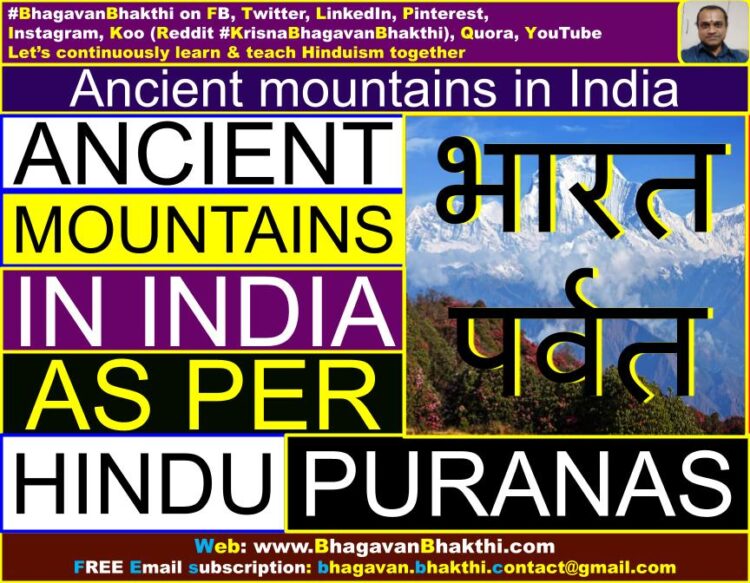
A Rishi / Sage named Sutaji (Sutacharya) narrated the tale of Bhagavan Lord Sri Varaha Swamy (An avatar of Bhagavan Lord Sri Vishnu) to the other Rishis / Sages, which he had heard from Bhagavan Lord (Sage) Sri Vedavyasa (An avatar of Bhagavan Lord Sri Vishnu).
Once, while Maharshi (Devarshi) Narada was wandering about, he reached Meru Parvata / mountain, where he saw the abode of Lord Sri Brahma Deva.
Maharshi (Devarshi) Narada also saw a giant sized entity, just next to Lord Sri Brahma Deva’s abode. That personality possessed chaturbhuja / four arms and his face resembled a boar. That personality held a shankha / conch and a chakra (disc) in his two hands.
The remaining of his two hands were in the postures of giving blessings. Maharshi (Devarshi) Narada was very surprised to see that divine personality being surrounded by Rishis / Sages like Maharshi Vashishtha, Maharshi Atri, Maharshi Markandeya, Maharishi Bhrigu and others.
After paying his eulogy to him, Maharshi (Devarshi) Narada stood in a corner. In the meantime, Mother Prithvi or Dharani Devi (Mother Earth) arrived there with her two companions, that is, Ila and Pingala.
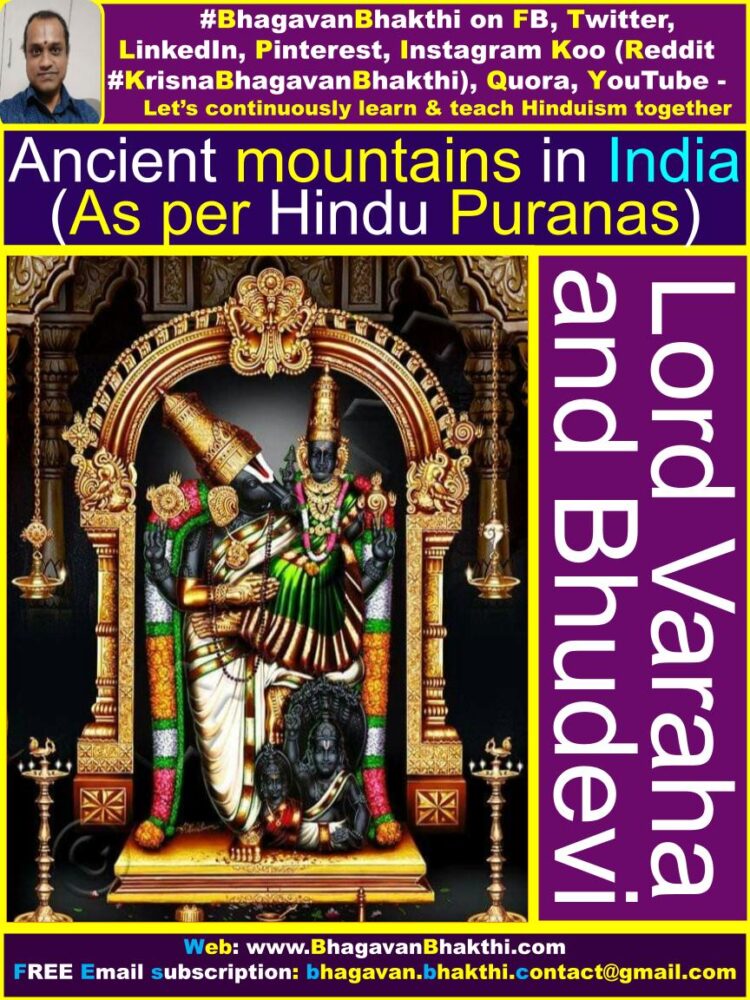
Mother Prithvi or Dharani Devi (Earth) was curious to know about the identities of various mountains, which Bhagavan Lord Sri Varaha had established on her.
(Note : In this post first let us know the names of the mountains of ancient India or as given in Hindu Puranas, later us know brief information about each of the ancient mountains in India as given in Hindu Puranas.)
Bhagavan Lord Sri Varaha Swamy told Mother Prithvi or Dharani Devi (Earth) about the prominent ancient mountains as below (All these are situated to the north of Himalaya):
1. Sumeru | 2. Himavan (Himalaya) | 3. Mandarachala (Mandar Parvat) | 4. Vindhyachala | 5. Pariyatra | 6. Mahendra | 7. Malaya | 8. Simhachalam | 9. Gandhamadana |
The mountain ranges situated to the south of Himalaya are as given here: 1. Arunachala | 2. Hasti | 3. Gridhachala | 4. Ghatikachala |
All Rishi / Sages believe that Bhagavan Lord Sri Vishnu had his abode in the following:
1. Satya Yuga at Anjanadri | 2. Treta Yuga at Narayanadri | 3. Dvapara Yuga at Simhadri | 4. Kali Yuga at Sri Venkatadri (All these names given here are the present different Tirupati mountains / Tirumala) |
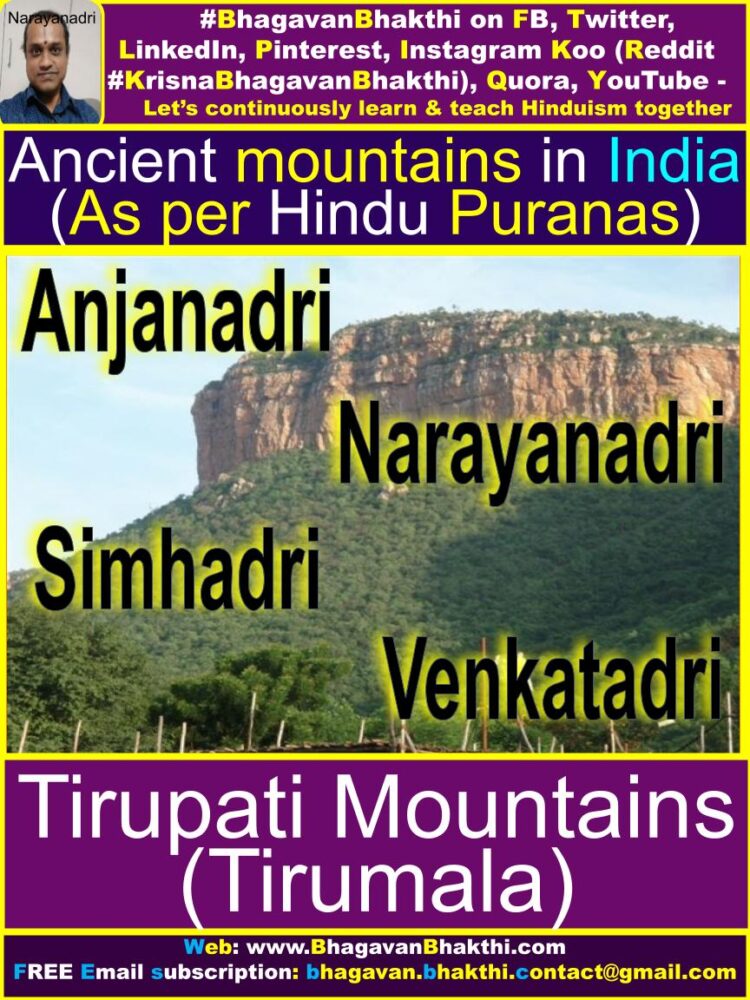
Lord Varaha and Mother Prithvi (Earth) flew away towards Venkatachala giri mountain (Today’s Tirupati Mountains / Tirumala) mounted on the King of the birds, that is, Lord Sri Garuda Raja.
LORD Varaha MANTRA : On their way, Mother Prithvi (Earth) requested Bhagavan Lord Sri Varaha Svami to reveal the sacred mantra, chanting of which makes him pleased.
Lord Varaha said: The secret mantra that pleases me to no limits is:
‘ॐ नमो श्री वराहाय धरण्यु उद्धरणाय स्वाहा’ | ‘ಓಂ ನಮೋ ಶ್ರೀ ವರಾಹಾಯ ಧರಣ್ಯು ಉದ್ಧಾರಣಾಯ ಸ್ವಾಹಾ.’ | ‘ōṁ namō śrī varāhāya dharaṇyu ud’dhāraṇāya svāhā.’
This mantra is capable of liberating a man and also brings all sort of worldly accomplishments to him. In the first Krita (Satya) Yuga, a Manu named Dharma had realized me by continuously chanting this mantra.
Even Indra regained the control of Swarga Loka (Heaven) by chanting this great mantra. Ananta Shesha (Adishesha), the Lord of all sarpas / serpents, chanted Varaha mantra and as a result became capable of holding the earth on it’s hood.
Brief information about the ancient mountains in India or as per Hindu Puranas (Texts) is as given below:
Sumeru Parvat (Mountain) : Mount Sumeru, also known as Mount Meru or Sineru or Mahameru, is a sacred five-peaked mountain. Etymologically speaking, it is pronounced as Meru (मेरु), to which the attributive prefix ‘su’ is added, resulting in the meaning “excellent or divine or wonderful Meru”.
Meru is also the name of the central bead in the mālā (garland). While explaining the qualities of King Priyavrata and his descendants, Sutaji or Sutacharya describes the planetary system called ‘Meru Parvata (Mountain)’ and Bhu-mandala (Earth).
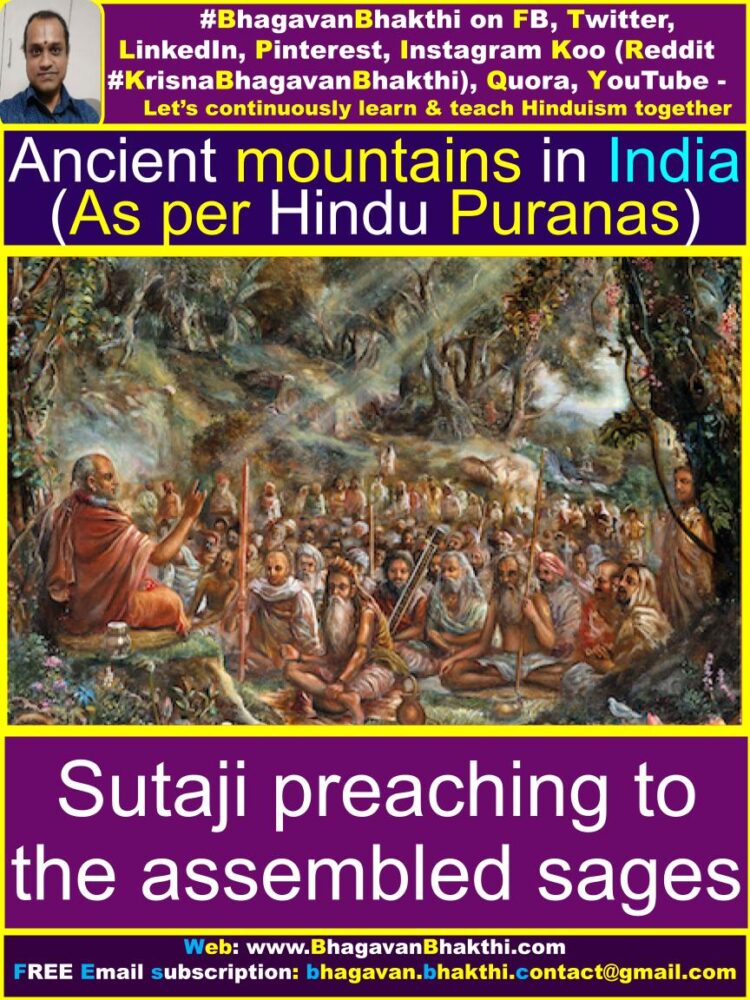
Bhu-mandala is like a lotus flower and its seven islands are compared to a lotus whorl. A place called Jambudweepa (Jambudvipa) is in the middle of that vortex. In Jambudvipa there is a mountain called Sumeru, which is made of solid gold.
The height of this mountain is 84,000 yojanas, of which 16,000 yojanas are below the earth. Sumeru Parvata (Mountain) width is estimated at 32,000 yojanas at its summit and 16,000 yojanas at its foot. (A yojana equals approximately eight miles.)
This king of mountains, that is, Sumeru Parvatam (Mountain), is the support of the earth. In the southern part of the land known as Ilavrita-varsha are the mountains known as Himavan, Hemakuta and Nishadha and in the northern part are the mountains Neela, Shweta and Shringa.
Similarly, on the east and west side are two big mountains called Malyavan and Gandhamadana. Surrounding Mount Sumeru are four mountains, Mandara, Merumandara, Suparshva and Kumuda, each 10,000 yojana long and 10,000 yojana high.
There are banyan trees in these four mountains. There are also lakes filled with milk, honey, sugarcane juice and pure water. These lakes can fulfill all desires. There are also gardens named Nandana, Chitraratha, Vaibhrajaka and Sarvatobhadra.
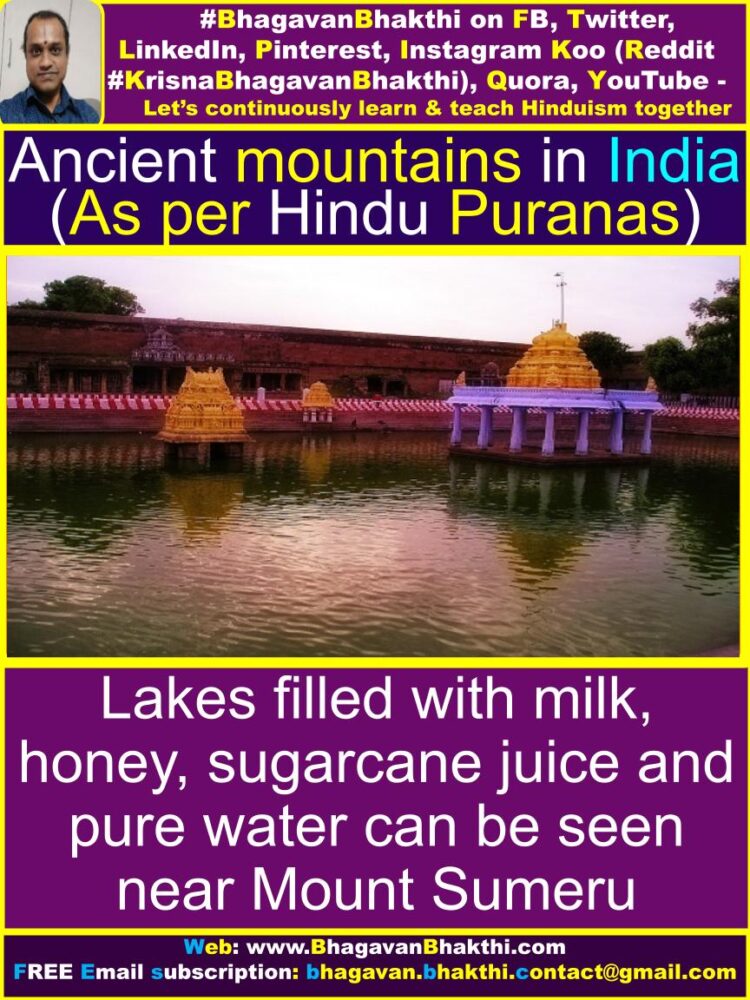
On the side of the Suparshva mountain is the Kadamba tree, from whose hollows flow streams of honey, and on the Kumuda mountain is the Shatavalsha banyan tree, from the roots of which flow rivers containing milk, yogurt and many other desirable things.
The twenty mountain ranges Kuranga, Kurara, Kusumbha, Vaikanka and Trikuta encircle Mount Sumeru like the coiled threads of a lotus. To the east of Sumeru are mountains Jathara and Devakuta, to the west are Pavana and Pariyatra, to the south Kailasa (Kailash) and Karaveera and to the north are Trishranga and Makara.
These eight mountains are about 18,000 yojanas long, 2,000 yojanas wide and 2,000 yojanas high. Brahmapuri is the abode of Lord Brahma on the summit of Mount Sumeru.
Each of its four sides is 10,000 yojanas long. Surrounding Brahmapuri are the cities of King Indra and seven other Devatas (Demigods). These cities are one-fourth the size of Brahmapuri (Lord Brahma abode, also called as Satya Loka or Brahma Loka).
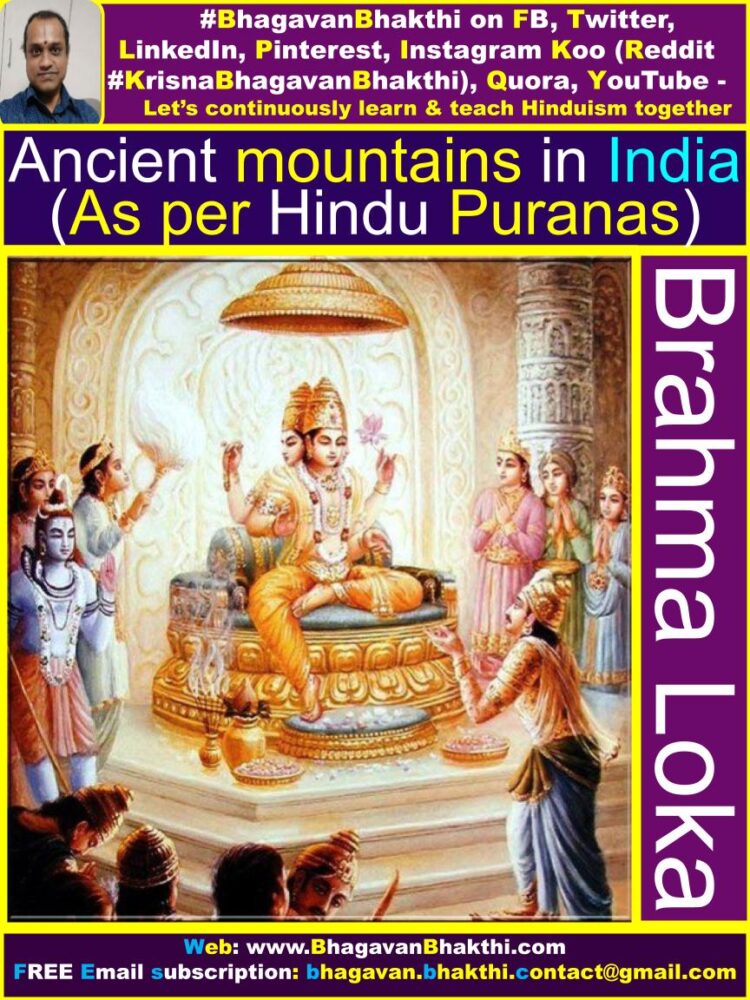
Himavan (Himalaya) Parvat (Mountain) : Himavan (Himavat) parents are Lord Brahma (father) and Goddess Saraswati (mother). The Himalayan king Himavat (Himavan) fathered the goddess Ganga, the river goddess, as well as Ragini, and also and Goddess Parvati, consort of Lord Shiva. Daughter of Mount Meru (Sumeru) and consort of Himavan (Himavat) was queen Mainavati.
Two of the most sacred pilgrimage sites for Hindus are the temple complex at Pashupatinath and Muktinath, also known as Saligrama or Shaligrama because of the presence of sacred black rocks in the form of Shaligrama (near Gandaki river) is located in Himalayas.
The mountain Mainaka was son of Himavan (Himavat) & Menadevi or Mainavati is the brother of Goddess Parvathi and brother-in-law of Lord Shiva. Mainaka mountain was made up of gold. In earlier days, all mountains had wings.
Knowing such a feature would be harmful to the public, when Lord Indra cut off the wings of other mountains, Lord Vayu had thrown Mainaka into the ocean. This enabled Mainaka to save his wings.
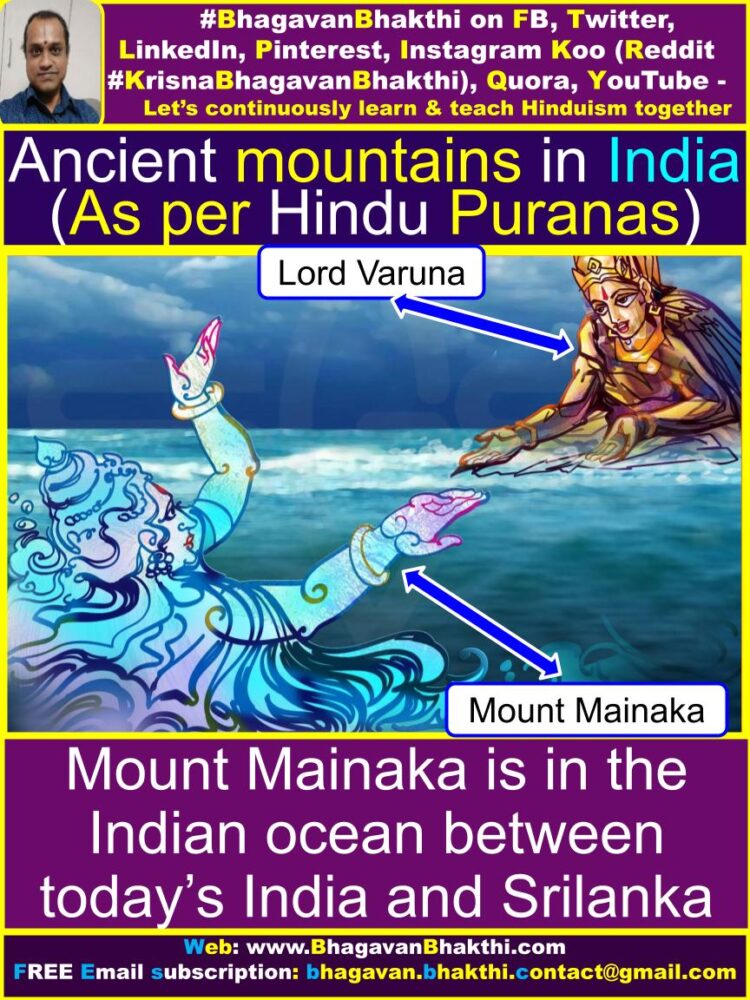
Mount Himavan (Himalayas) and Mahabharata relationship is as given below:
Balakhilya did penance on the Himalayas. A Naga named Sesha once lived there to practice mind control in seclusion. Lord (Sage) Sri Vedavyasa did penance there. Pandu, the father of the Pandavas, had to cross the Kalakuta mountain and the Himalayas to reach Gandhamadana.
As suggested by Lord Surya, once Narada did penance for 1000 years in the peaks of Himalayas to see the assembly of Lord Indra (Swarga Loka or Indra Loka). Arjuna once crossed the Himalayas and camped at Dhavalagiri. Merusavarni advised Yudhishthira in the Himalayas.
Bhagiratha performed penance on the Himalayas. Kalinda King Subahu’s kingdom was in the Himalayan plains. The Pandavas stayed there for one night and the next day left for the Himalayas.
The Pandavas, on the seventeenth day of their life in forest exile, reached the foothills of the Himalayas and visited the hermitage of Vrishaparvan there. Maharshi (Sage) Markandeya once saw Himalayas, Hemakuta etc. in the stomach of Bala (Child) Krishna.
Karna conquered all the upper Himalayan kingdoms and collected taxes from all. Lord Shiva and Goddess Parvati reside forever in the northern heights of the Himalayas (Mount Kailasa or Kailash). When Lord Shiva burnt the Tripusuras to ashes, Himavan and Vindhya served as the axles of Lord Shiva’s chariot.
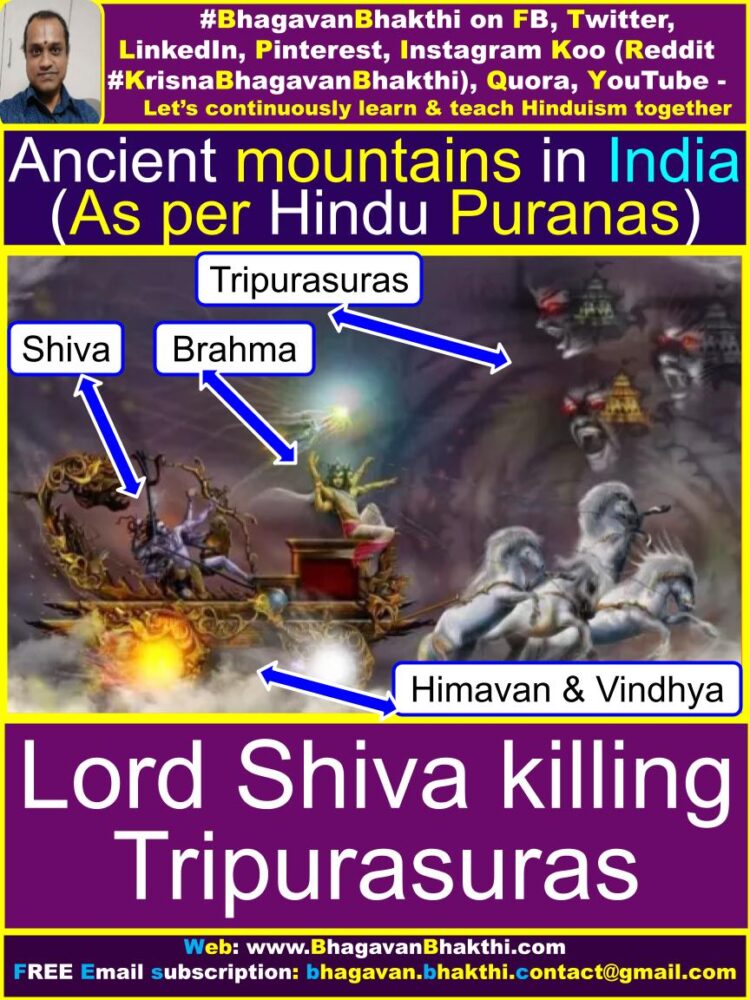
Lord Krishna once performed penance on Mount Himavan and as a result his son Pradyumna was born to Goddess Rukmini. Emperor Himavan offered inexhaustible wealth to Prithu. The peaks of Himavan have an area of 100 yojanas. Once Lord Brahma performed a yajna there.
Dakshaprajapati once performed a yajna at a place called Gangadwara on the slopes of Himavan. Lord Krishna once visited Upamanyu’s ashram in Himavan. King Marut performed a yajna on the Himalayas and the Brahmins left a lot of wealth there.
After Dhritarashtra and Gandhari were burnt to death in a fire, Sanjaya the charioteer of Dhritarashtra left for the Himalayas.
During their Mahaprasthan (Great Journey) the Pandavas traveled through the Himalayas and Dharmaputra (Yudhishthira) ascended to Swarka Loka (Heaven) from the peak of the Himalayas.
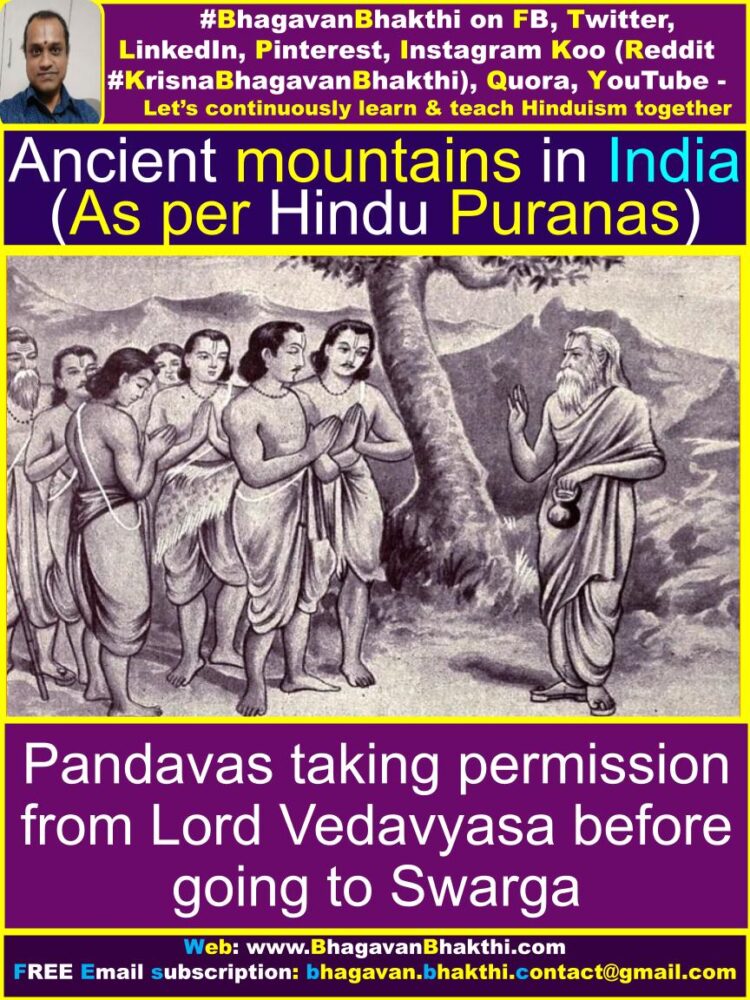
Mandarachala (Mandar Parvat) (Mountain) : In Sanskrit this name is written as मन्दार पर्वत (mandāra parvata). Mandara (Mandar) Parvat is the name of a mountain on the eastern side of Mount Meru, according to a chapter in Varahapurana.
The Kadamba tree at the peak of Mandara mountain shelters various Devatas (Demigods), asuras (demons) and apsaras. The lake in this direction is called Arunoda, surrounded by eleven mountains.
Mandara is another name for Kakudra, one of the seven major mountains of Kushadweep according to chapter 87 of the Varahapurana. Kushadweepa is one of the seven islands (dweepa), ruled by Vapushman, son of Priyavrata. Son of Swayambhu Manu.
Mandara is the name of a mountain found in the Samudra Manthan (churning of the ocean) episode in Hindu Puranas, where it is used as a churning rod to churn the milky ocean (Kshira Sagara). Lord Shiva’s serpent, Vasuki, offered to serve as a rope pulled by a troop of Asuras (Demons) on one side, and a troop of Devatas (Demigods) on the other.
But when the churning began, Mandara Parvata began to sink into the sea. Then again the Devatas (Demigods) prayed to Lord Vishnu for help who took the form of Kurma or Tortoise form to float the mountain.
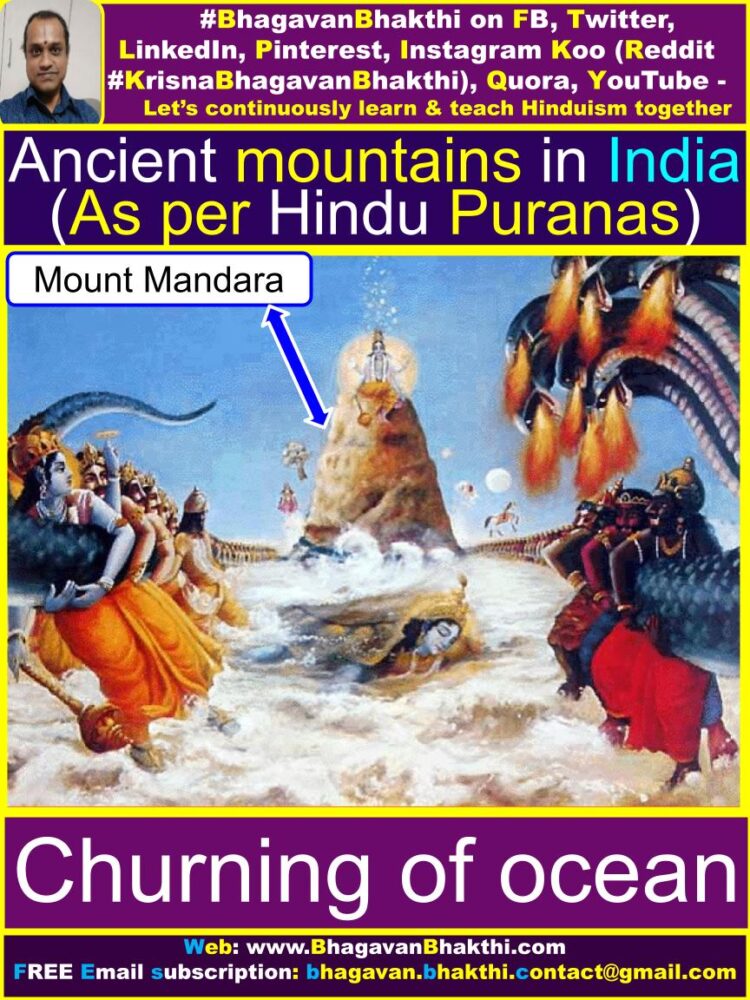
This Koormakruthi was spread about 100 Yojana and was holding the Mandara mountain throughout the Samudra Mathana Process for so many years. This operation spanned about 100 Yajanas and held Mandara Parvata for many years throughout the Samudra Mathan (Churning of ocean) process.
Thus Kurma Jayanti is celebrated to commemorate Lord Vishnu’s second incarnation as Lord Kurma. Thus Lord Vishnu is the sole reason for the churning of the sea. Devatas (Demigods) and Asuras (Demons) were told to churn the sea. When the Mandara mountain was sinking, Lord Kurma took the avatar and held the mountain.
From asuras (demons) side King Bali Mahabali was captaining this operation, while from the Devatas (Demigods) side Lord Indra was the prominent Devata (Demigod).
The Puranas refer to various holy places on the Mandara hill, which are believed to be the abode of Lord Krishna, the destroyer of the demon Madhusudana or Madhu, who was killed by Krishna and later covered by the Mandara mountain.
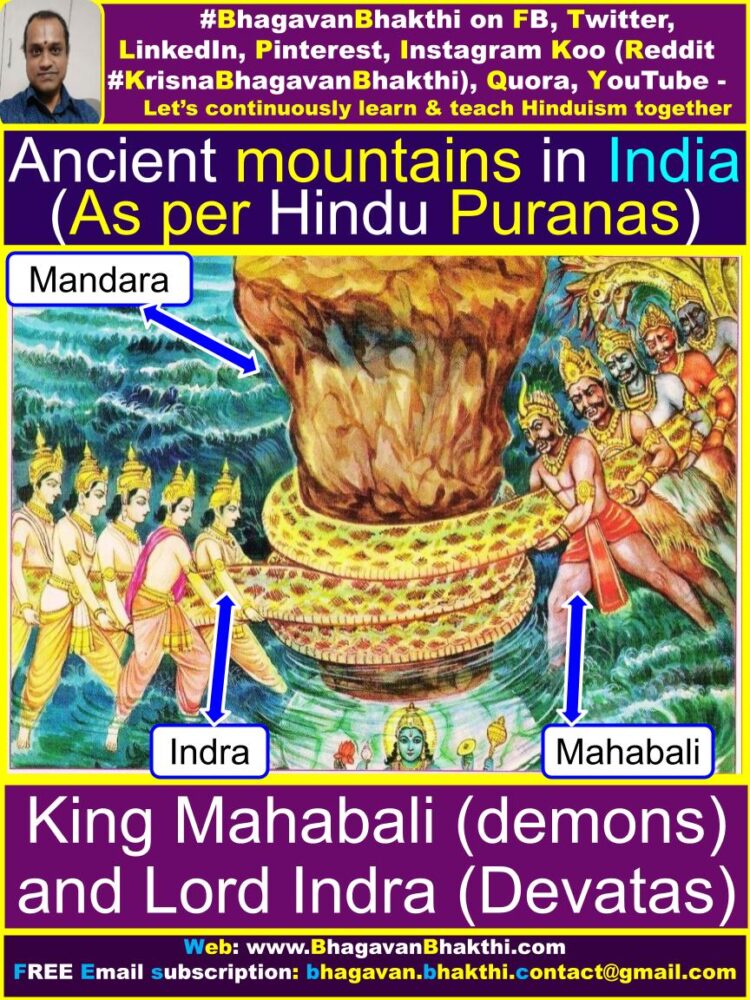
Vindhyachala Parvata (Mountain) : The word ‘Vindhya’ is derived from the Sanskrit word ‘Vaindh’, which means ‘blocking the way’. According to another theory, the name “Vindhya” also means “hunter” in Sanskrit, and may refer to the tribal hunter-gatherers living in the region.
The Vindhya Range is also known as “Vindhyachal” or “Vindhyachal”. The suffix ‘achal or achala’ in Sanskrit means something which cannot be moved (immobile) or a mountain. In the Mahabharata, the range is also referred to as ‘Vindhyapadaparvata’.
Story of Mount Vidhyachal and Maharshi Agastya : Maharshi (Sage) Agastya saved the then Bharata Varsha (India) from imbalance. According to a story in the Ramayana, Mount Vindhyachal was constantly growing in size due to the taunting comments of Devarshi (Sage) Narada.
So to assuage the vanity of the mountains, Maharshi (Sage) Agastya and his family traveled from South India through the Vindhyachal mountain.
On their way, when the Mountain Vindhyachal saw Maharshi (Sage) Agastya, it bowed with reverence and respect, upon which the Maharshi (Sage) Agastya asked the Vindhyachal whether it would be occupied with respect until the Sage’s return.
Vindhyachal was indeed benevolent and promised not to grow until the return of the seer from the south. After passing through the mountain, Sage Agastya told his wife that he would no longer return to the northern side of the Vindhya mountain.
They settled on the southern shores of the Godavari region. For this reason we say ‘देववर्य दक्षिणे तीरे’ (dēvavarya dakṣiṇe tīre) during any Hindu rituals for the whole of South India.
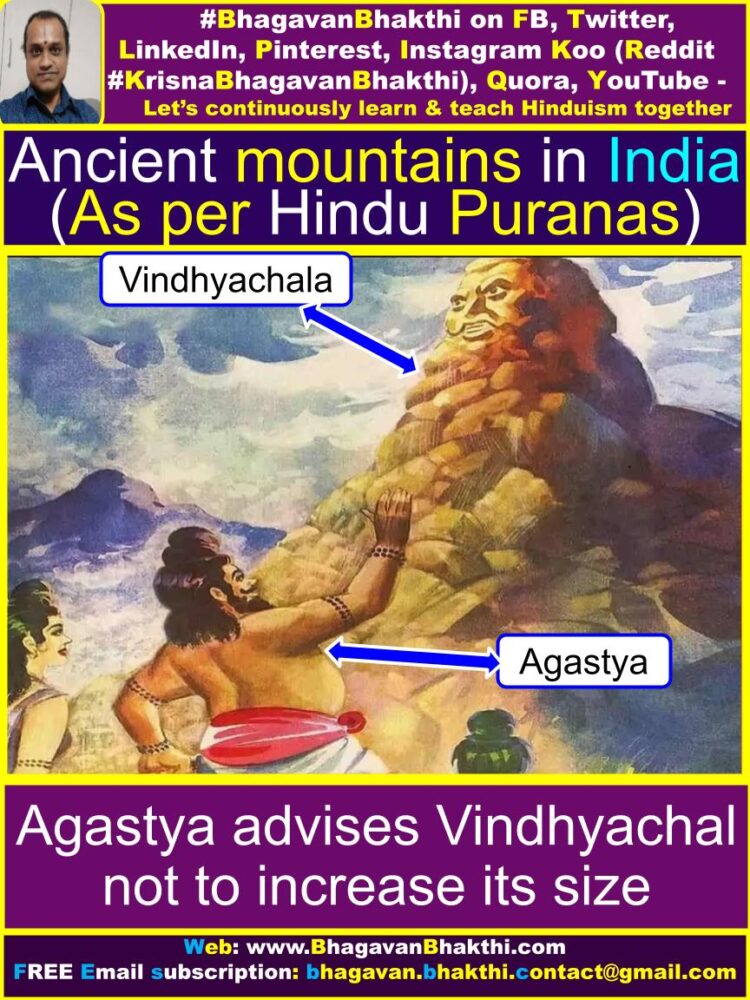
Pariyatra Parvat (Mountain) : In Sanskrit it is written as पारियात्र (Pāriyātra). To the east of Sumeru are mountains Jathara and Devakuta, to the west are Pavana and Pariyatra, to the south Kailasa (Kailash) and Karaveera and to the north are Trishranga and Makara.
According to Harivamsa Purana 2.74.15 Lord Sri Krishna changed the name of Pariyatra mountain to “Sanapada”.
According to chapter 85 of Varahapurana, Pariyatra mountain is one of the seven sacred mountains (Kulaparvata) in India, the region south of Mount Meru. Settlements (janapada) along these mountains are inhabited by Aryans and Mlechhas, who drink water from flowing rivers there.
The deity of this Pariyatra mountain is a member of Lord Kubera’s court. The ashram (hermitage) of the famous Maharshi (Sage) Gautama is located on this mountain. Maharshi (Sage) Markandeya once saw this mountain in Balamukunda’s stomach. This mountain is on the western side of Mahameru.
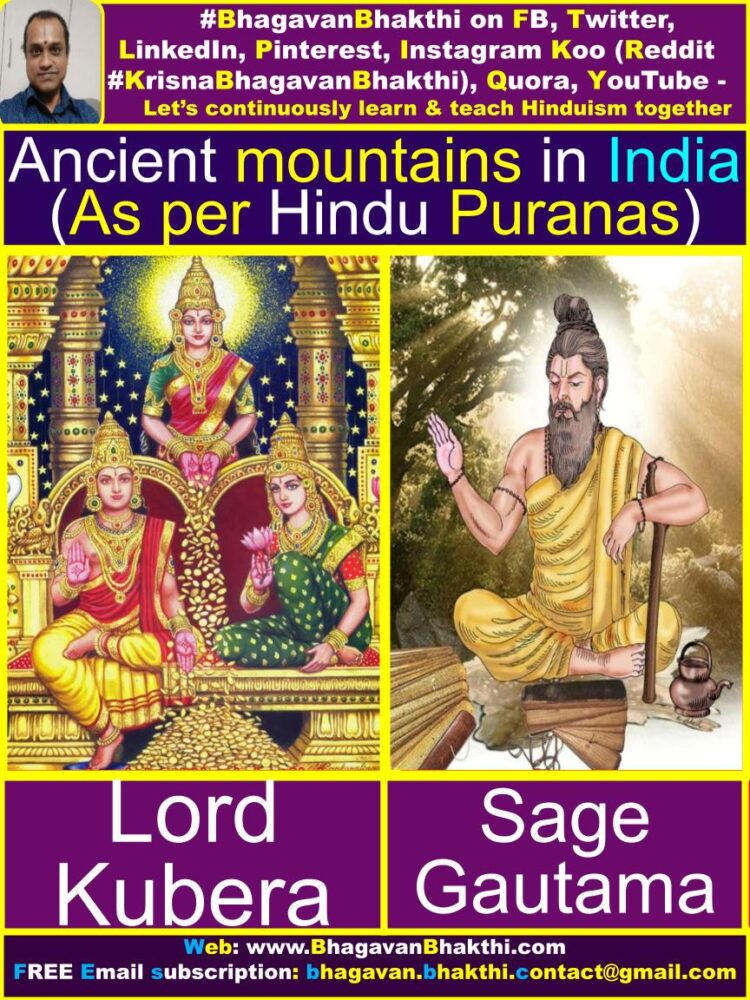
Mahendra Parvata (Mountain) : Mahendra Parvat is the hill where Hanuman stood before flying into the sky to reach Lanka. With the force he exerted, most of the hill sank into the earth. The mountain went into the earth to convey a message to Bhudevi (Mother Earth) about her daughter Sita.
Even today Parasurama, an incarnation (avatar) of Lord Sri Vishnu resides at Mahendra Parvat for the peace, prosperity and happiness of the world.
Once Balarama had bathed in the Gangasagar, completed the daily rituals and sees Lord Parashurama (An avatar of Lord Sri Vishnu) on Mahendra Parvat.
Balarama proceeded towards Lord Parashurama, and bowed down to him and prayed to him and then he bathed in the seven branches of the Godavari River and also in the rivers Vena, Pampa and Bhimarathi rivers.
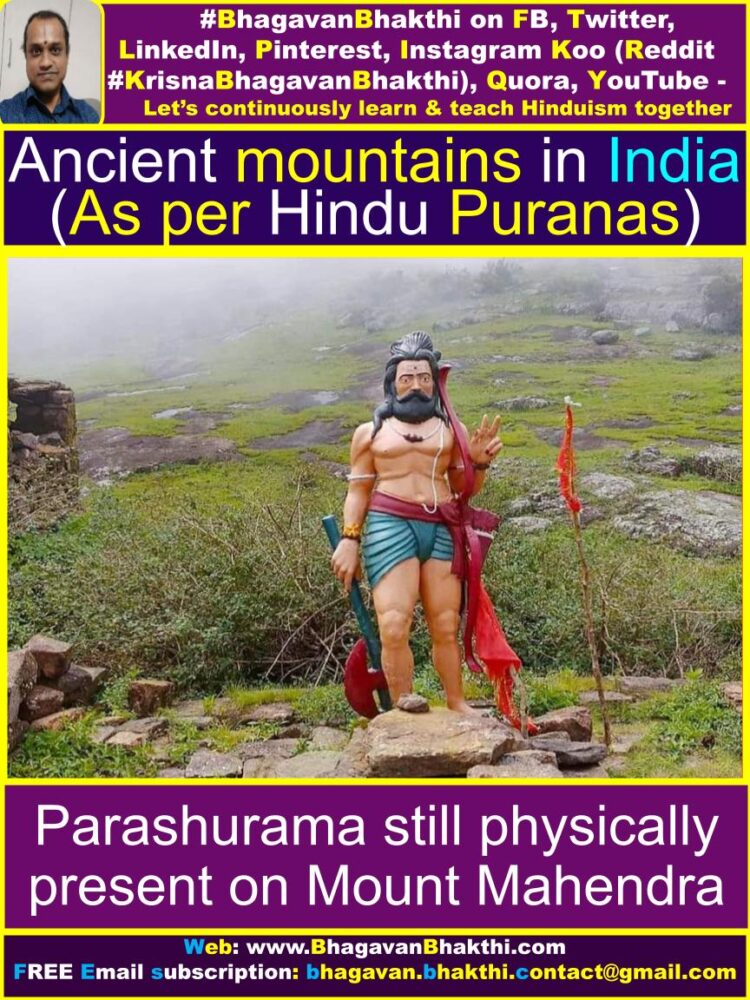
Malaya Parvat (Mountain) : The Malaya Mountains are a range of mountains mentioned in Hindu holy texts such as Matsya Purana, Kurma Purana, Vishnu Purana and the great epics Ramayana and Mahabharata.
The Vishnu Purana specifically recognizes Mount Malaya as among the seven major mountain ranges of India, namely Mahendra, Malaya, Sahya, Shuktimat, Riksha, Vindhya and Paripatra. According to the Matsya Purana, during the great flood, King Manu’s giant boat rested after the deluge on the Malaya mountains.
These mountains are believed to have formed the southern part of the Western Ghats of modern day Kerala (starting from Mangalore region to the south), while its northern part was known as the Sahya Mountains. The peaks of this Mount Malaya are said to be higher than Sahya mountain.
Once King Indradyum retired from family life and went to the Malaya Hills, where he had a small cottage for his hermitage. He wore a braid on his head and was always engaged in penance. Once observing a vow of silence, he became fully engaged in the worship of the Lord Sri Vishnu and became engrossed in the ecstasy of the love of the Supreme Lord Sri Vishnu.
At Setubandha (Rameswaram) Balarama donated ten thousand cows to the Brahmins. He then visited the Kritamala and Tamraparni rivers and the great Malaya mountains.
On the Malaya mountain range Balarama saw Maharshi (Sage) Agastya sitting in meditation position. After giving salutations to the sage, the Balarama offered prayers to Sage Agastya and then took blessings from him.
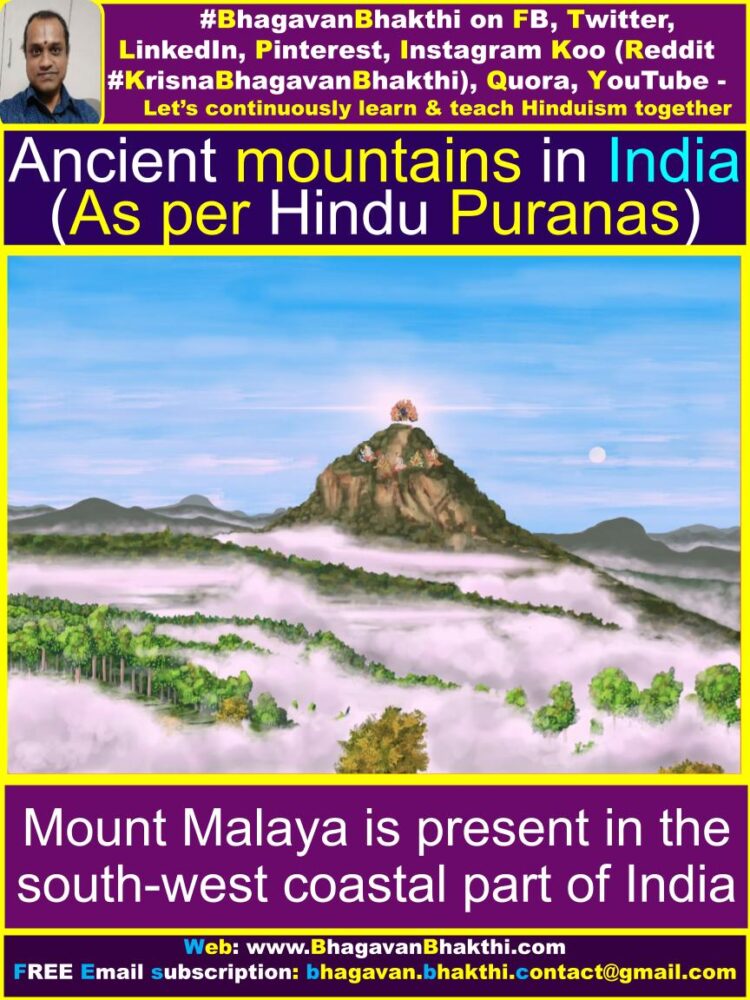
Simhachalam Parvata (Mountain) : This mountain is also known as Simhadri (Sinhadri). According to Simhachala Kshetra Mahatmya, Akshaya Tritiya is a holy and auspicious day. Lord Vishnu appeared in dual form (Varaha + Lord Narasimha) in Simhachalam Kshetra during Krita or Satya Yuga.
At first Lord Vishnu took the incarnation of Lord Varaha at this place to the save Goddess Dharini Devi or Bhudevi or Mother Earth from the clutches of the demon Hiranyaksha.
Later, Lord Vishnu took the incarnation of Lord Sri Narasimha to save his great devotee Prahlada from the demon king Hiranyakashipu (Hiranyakashyap).
For this reason there is a very famous Lord Varaha and Lord Narasimha temple called ‘Varaha Lakshmi Narasimha temple’ here even today. As Lord Vishnu took two incarnations at this place, the place came to be known as Simhachalam. Here simha means lion and achalam means can’t be shaken or a mountain.
Lord Vishnu assumed the form of Varaha and Narasimha at this place. After the death of Hiranyakashipu, Prahlada built the temple. Puja was performed and the place was named Simhachalam (Lion Hill).
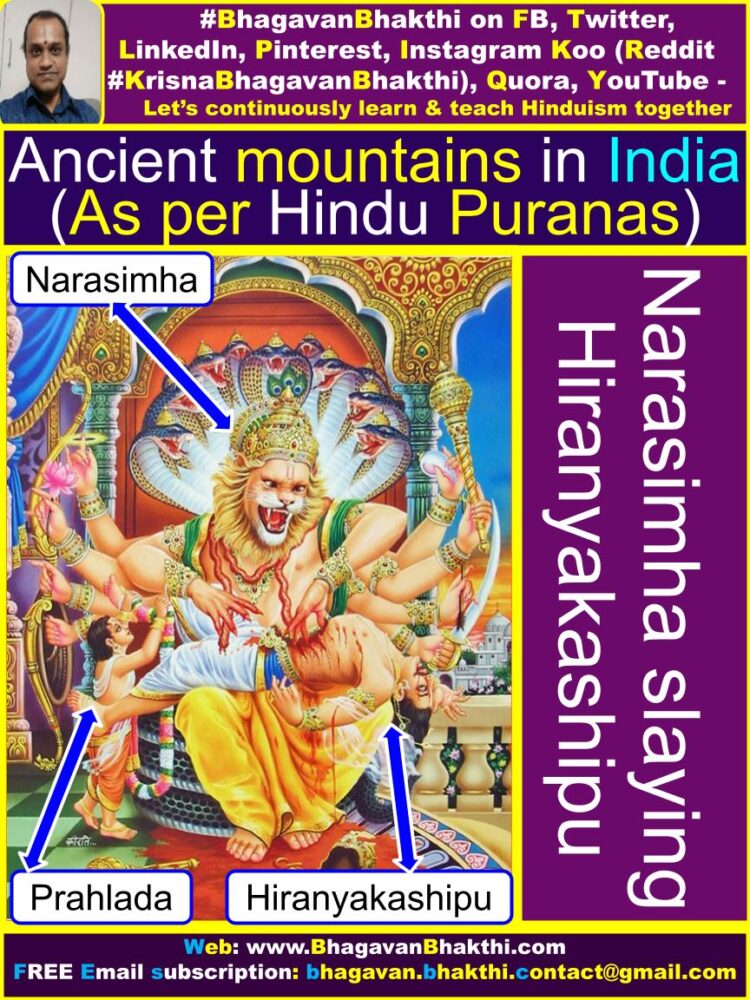
After a long time, the temple built by Prahlada was neglected and subsequently fell into disrepair. The base of temple of Varaha Narasimha was surrounded by mud peaks. In another life cycle, King Pururava of the Chandravansh (Lunar Dynasty) received the Pushpaka Vimana (divine air car) as a boon from Lord Brahma.
Once Purura saw an apsara named Urvashi on Mount Kailasa (Kailash) and both fell in love. They visited Simhachalam mountain and settled here for some time. Urvashi remembers a dream and locates the deity of Varaha Narasimha. Pururava did penance in Gangadhara for that. He dug up the deity and installed it after renovation.
No matter how hard Pururava tried, he could not find the feet of the deity. A divine voice comforted him, telling him that he need not worry about it, that the deity could provide salvation in its present form too to all his devotees.
Urvashi was instructed in a dream to cover the deity of Varaha Narasimha with a coating of sandalwood for the entire year except on the third day of the month of Vaishakha. This custom is still strictly practiced today.
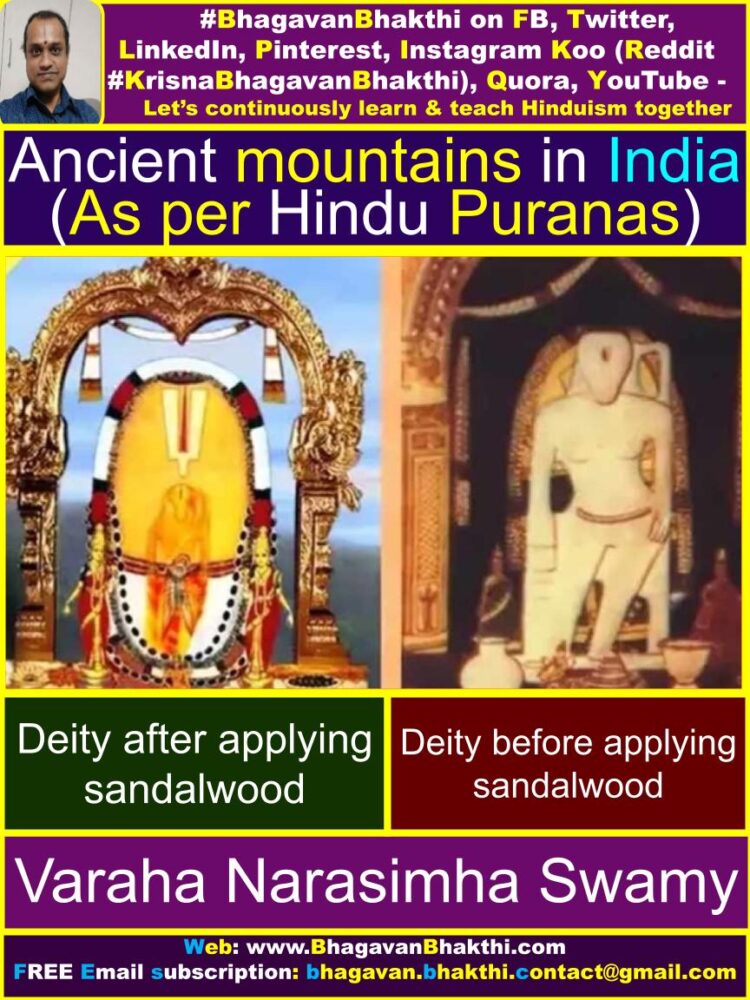
Gandhamadana Parvat (Mountain) : To the west and east of Ilavrita-varsha are two great mountains, Malyavana and Gandhamadana respectively. These two mountains, 2,000 yojanas (16,000 miles) high, extend to Nila Parvata in the north and Nishadha in the south.
They indicate the boundaries of the Ilavrita-varsha and the Varshas known as Ketumala and Bhadrashva. From the Kesarachala mountains, the Ganga falls to the peak of the Gandhamadana mountain and then flows into the land of Bhadrashva-varsha. Eventually it reaches the ocean in the west.
Once upon a time there were no suitable kings after the Prachetas. Thus, Swayambhuva Manu went to Gandhamadana Hill to bring back his eldest son Priyavrata who was meditating there.
Swayambhuva Manu directed Priyavrata to rule the entire world. When he refused, Lord Brahma descended from Satyaloka to instruct Priyavrata to accept his father’s order.
Once Bhima and Draupadi were staying at Gandhamadana mountain. After some time on Mount Gandhamadana, Draupadi found a five-colored flower from Lord Kubera’s lotus garden and asked Bhima to bring some.

Draupadi wanted to kill the demons in this garden. For this reason, Bhima went to this garden and brought some lotus flowers as requested by Draupadi and also killed those demons.
Here in this garden the demons took the form of wild beasts. So, Bhima immediately started climbing that Gandhamadhana mountain and he killed many wild lions and elephants by throwing elephants upon elephants and lions upon lions. There was no fear or tiredness while climbing.
Once Muchukunda reached a mountain called Gandhamadana, where there were many trees like sandalwood and other flowering trees, the fragrance of which delighted anyone who reached there.
Muchukunda decided to stay in that Gandhamadana mountain region to perform austerities and tapasya for the rest of his life. This place seems to be situated in the northern part of the Himalayan mountains, where Nara-Narayana have the abode (Today’s Badrinath).
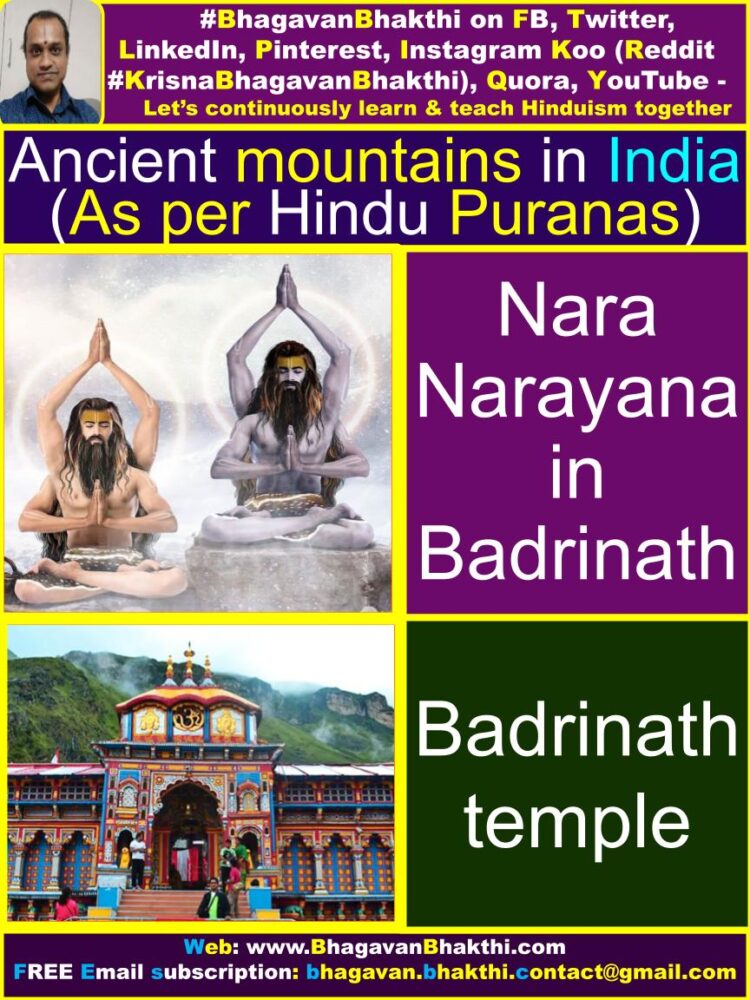
Arunachala Parvat (Mountain) : In Sanskrit this is written as अरुणाचल पर्वत (aruṇācala parvata). This place is now called as ‘Tiruvannamalai‘. Among the five type of Lingas, Agni Linga is present here in Tiruvannamalai or Arunachalam.
Here Lord Shiva is called as Sri Arunachalesvara (Arunachalam) and Goddess Sri Parvati Devi is called as Unnamalai Amman.
Here it is stated that, may the Lord of Goddess Sri Parvati Devi (Lord Shiva), someone who wears snakes as precious jewels, someone whose form is appreciated by Goddess Sri Parvati Devi, someone who gets angry at evil,
someone who removes the faults of his own devotees, someone who is the Lord of Lord Indra, Lord Surya and other Devatas (Demigods), someone who relieves us from the bondage of Sansar (Samsara) (From birth until death), someone who resides in the excellent aruna (chala) hill, let him protect me!
Arunachalam (Tiruvannamalai) (Arunachalesvara) is situated around 180 kms from Chennai in Tamil Nadu. It is also known as ‘Arunachala or Arunachaleshwara or Arunachalesvara‘. The hill itself is believed to be the ‘Agni Tattva Linga‘ of Lord Shiva.
On the occasion of ‘Kartika Purnima‘, a special jyoti (divine light) is lit on top of this hill, and is considered highly auspicious.
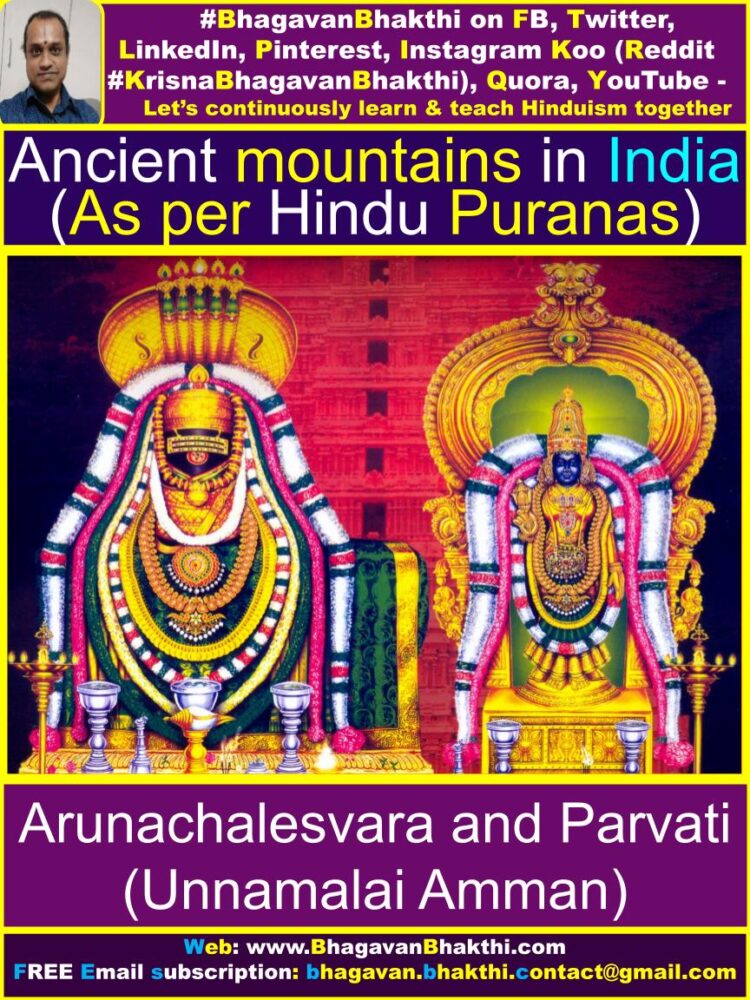
Continue reading about Venkatadri mountains (Tirupati mountains / Tirumala) from here : Venkatadri mountains (Tirupati mountains / Tirumala) information, significance, importance, facts etc.
More information will be added to this on regular basis. Please visit this post after some time to get updated information.
To watch videos on #Hinduism #Sanskrit language, SUBSCRIBE to my YouTube channel from this below link:
#BhagavanBhakthi YouTube channel
To know more about the “numbers importance, significance, facts in Hinduism“, visit the below link:
Numbers importance, significance, facts in Hinduism
Dear friends, if you need any clarifications about this post, kindly let me know, I will definitely try to answer all of them.
Also your one LIKE, one COMMENT, One Share, one SUBSCRIPTION is highly important.
This will help to know the quality of this content and also it will be helpful to know if any improvements is required for the content.
If you feel this content is useful to you and has helped you to improve your knowledge, kindly share this with your well-wishers.
Because “SHARING MEANS CARING”.
For receive FREE EMAIL SUBSCRIPTION about #BhagavanBhakthi, you can send an email to [email protected] from your email ID.
NAMASTE!
Sri Gurubhyo Namaha
Sri Krishnaaya Namaha
Sri Krishnaarpanamastu
Share in Social Media